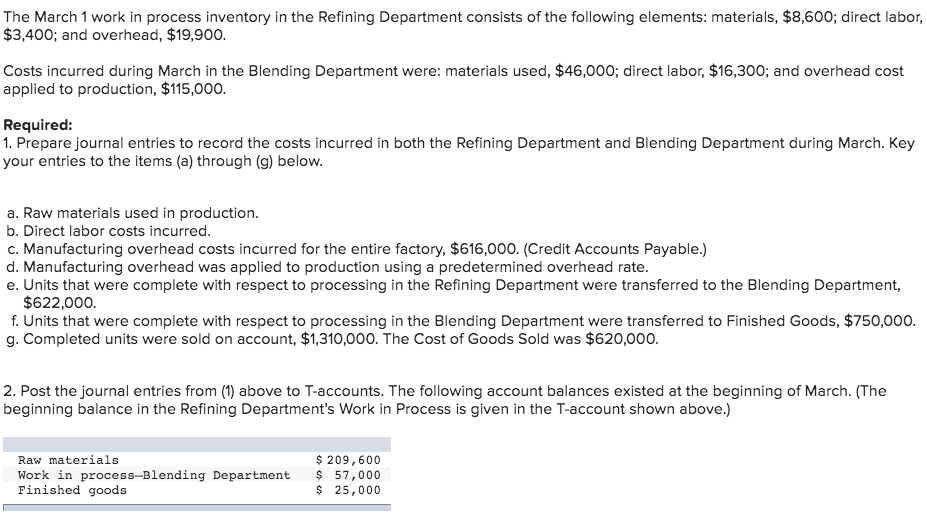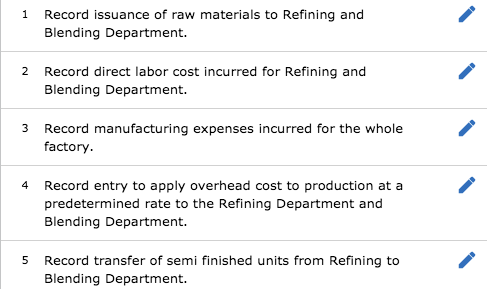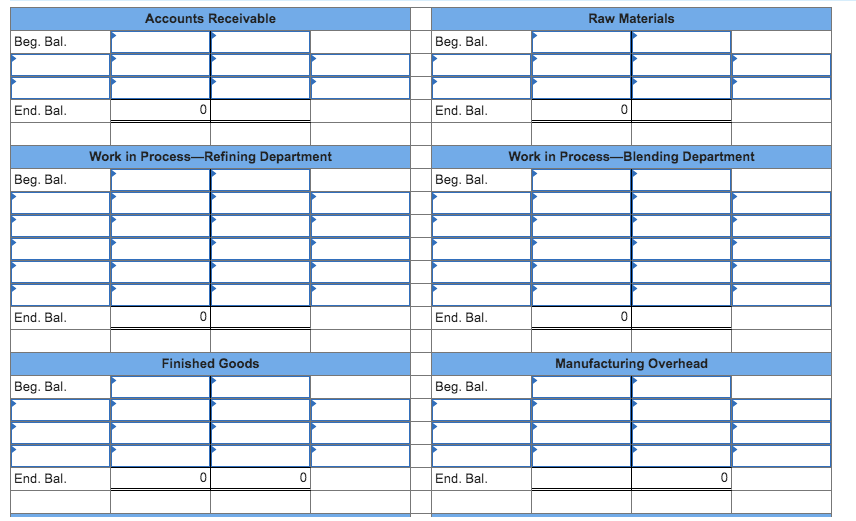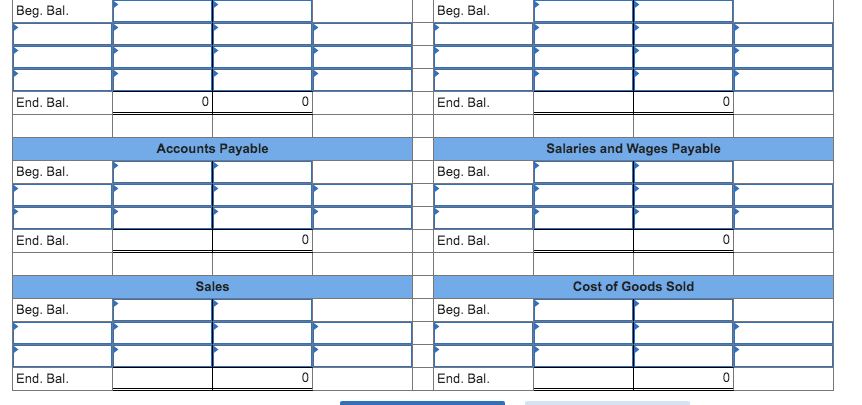




The March 1 work in process inventory in the Refining Department consists of the following elements: materials, $8,600; direct labor, $3,400; and overhead, $19,900. Costs incurred during March in the Blending Department were: materials used, $46,000; direct labor, $16,300; and overhead cost applied to production, $115,000. Required: 1. Prepare journal entries to record the costs incurred in both the Refining Department and Blending Department during March. Key your entries to the items (a) through (g) below. a. Raw materials used in production. b. Direct labor costs incurred. c. Manufacturing overhead costs incurred for the entire factory, $616,000. (Credit Accounts Payable.) d. Manufacturing overhead was applied to production using a predetermined overhead rate. e. Units that were complete with respect to processing in the Refining Department were transferred to the Blending Department, $622,000. f. Units that were complete with respect to processing in the Blending Department were transferred to Finished Goods, $750,000. g. Completed units were sold on account, $1,310,000. The Cost of Goods Sold was $620,000. 2. Post the journal entries from (1) above to T-accounts. The following account balances existed at the beginning of March. (The beginning balance in the Refining Department's Work in Process is given in the T-account shown above.) Raw materials Work in process-Blending Department Finished goods $ 209,600 $ 57,000 $ 25,000 1 Record issuance of raw materials to Refining and Blending Department. 2 Record direct labor cost incurred for Refining and Blending Department. 3 Record manufacturing expenses incurred for the whole factory. 4 Record entry to apply overhead cost to production at a predetermined rate to the Refining Department and Blending Department. 5 Record transfer of semi finished units from Refining to Blending Department. 6 Record the transfer of completed units from the Blending Department to finished goods. 7 Record sales on account. 8 Record cost of goods sold. Accounts Receivable Raw Materials Beg. Bal. Beg. Bal. End. Bal. 0 End. Bal. 0 Work in Process-Refining Department Work in ProcessBlending Department Beg. Bal. Beg. Bal. End. Bal. 0 End. Bal. Finished Goods Manufacturing Overhead Beg. Bal. Beg. Bal. End. Bal. 0 0 End. Bal. 0 Beg. Bal. Beg. Bal. End. Bal. 0 0 End. Bal. 0 Accounts Payable Salaries and Wages Payable Beg. Bal. Beg. Bal. End. Bal. 0 End. Bal. 0 Sales Cost of Goods Sold Beg. Bal. Beg. Bal. End. Bal. 0 End. Bal. 0 The March 1 work in process inventory in the Refining Department consists of the following elements: materials, $8,600; direct labor, $3,400; and overhead, $19,900. Costs incurred during March in the Blending Department were: materials used, $46,000; direct labor, $16,300; and overhead cost applied to production, $115,000. Required: 1. Prepare journal entries to record the costs incurred in both the Refining Department and Blending Department during March. Key your entries to the items (a) through (g) below. a. Raw materials used in production. b. Direct labor costs incurred. c. Manufacturing overhead costs incurred for the entire factory, $616,000. (Credit Accounts Payable.) d. Manufacturing overhead was applied to production using a predetermined overhead rate. e. Units that were complete with respect to processing in the Refining Department were transferred to the Blending Department, $622,000. f. Units that were complete with respect to processing in the Blending Department were transferred to Finished Goods, $750,000. g. Completed units were sold on account, $1,310,000. The Cost of Goods Sold was $620,000. 2. Post the journal entries from (1) above to T-accounts. The following account balances existed at the beginning of March. (The beginning balance in the Refining Department's Work in Process is given in the T-account shown above.) Raw materials Work in process-Blending Department Finished goods $ 209,600 $ 57,000 $ 25,000 1 Record issuance of raw materials to Refining and Blending Department. 2 Record direct labor cost incurred for Refining and Blending Department. 3 Record manufacturing expenses incurred for the whole factory. 4 Record entry to apply overhead cost to production at a predetermined rate to the Refining Department and Blending Department. 5 Record transfer of semi finished units from Refining to Blending Department. 6 Record the transfer of completed units from the Blending Department to finished goods. 7 Record sales on account. 8 Record cost of goods sold. Accounts Receivable Raw Materials Beg. Bal. Beg. Bal. End. Bal. 0 End. Bal. 0 Work in Process-Refining Department Work in ProcessBlending Department Beg. Bal. Beg. Bal. End. Bal. 0 End. Bal. Finished Goods Manufacturing Overhead Beg. Bal. Beg. Bal. End. Bal. 0 0 End. Bal. 0 Beg. Bal. Beg. Bal. End. Bal. 0 0 End. Bal. 0 Accounts Payable Salaries and Wages Payable Beg. Bal. Beg. Bal. End. Bal. 0 End. Bal. 0 Sales Cost of Goods Sold Beg. Bal. Beg. Bal. End. Bal. 0 End. Bal. 0











